Family : Megalopidae

Text © Giuseppe Mazza

English translation by Mario Beltramini
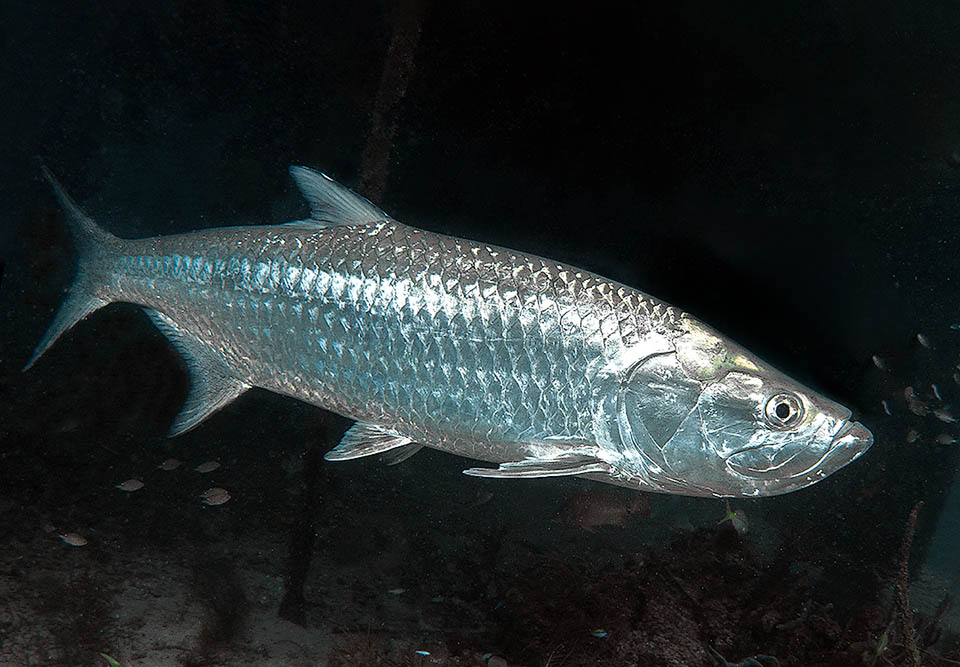
Present in tropical and subtropical waters on both sides of the Atlantic but also in freshwater, Megalops atlanticus may exceed 2 m with big scales © Karen Honeycutt
Known as Tarpon or, more gracefully, as Silverking among the dogged American sport fishermen, Megalops atlanticus Valenciennes, 1847, belongs to the class of the Actinopterygii, the ray-finned fishes, to the order of the Elopiformes and to the family of the Megalopidae that counts only one genus and two species: Megalops atlanticus in the Atlantic Ocean and Megalops cyprinoides in the Indo-Pacific. They stand among the oldest extant fishes, who were already circulating, as evidenced by fossils, of 180 million years ago.
The genus Megalops comes from the Greek “μέγας” (mégas), big and “ὦψ” (ṓps), eye, highlighting this anatomical detail even if some, given that in addition to eye the Greek term means also appearance, suggest that it could be a reference to the big size of the fish. The specific term atlanticus, of the Atlantic in Latin, indicates the place where it lives.
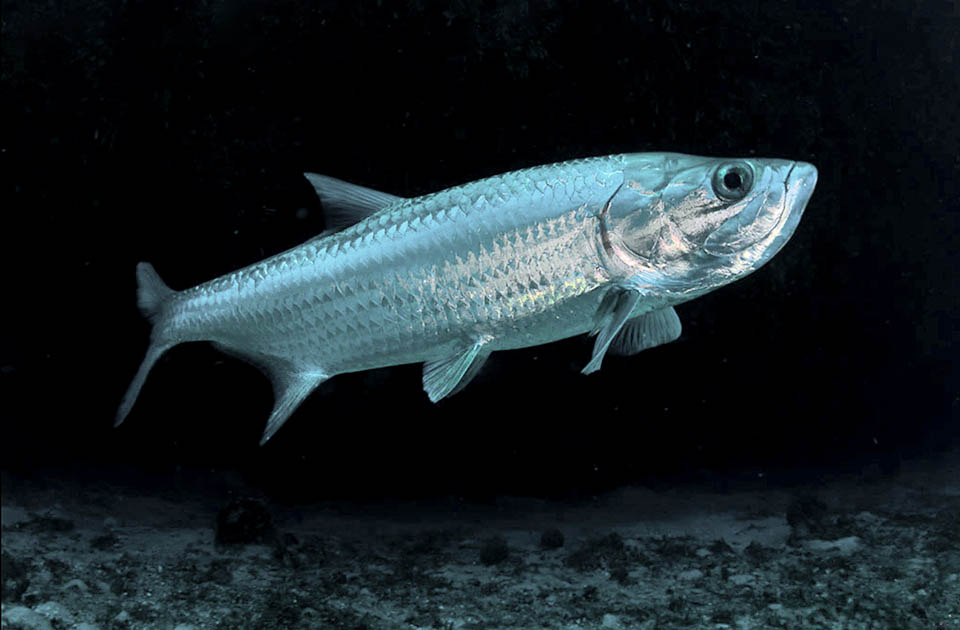
Already extant in the late Jurassic, it can breath air in waters poor in oxygen with the vascularized swim bladder, connected with the oesophagus, that acts as lung © Wolfram Sander
Zoogeography
Megalops atlanticus is present in the tropical and subtropical waters of the American coast: frequent all over the Gulf of Mexico, Florida and the Caribbean, it also reaches, to north, New Scotland and Bermudas and, south, all Brazil.
In the eastern Atlantic it can be found, starting from the Irish coasts, along those of Portugal, Spain, Açores, Canary Islands, Cape Verde and Mauritania up to Angola. They live in waters including 22 and 28 °C. Under the 16 °C they are inactive, whilst at temperatures below 4 °C thay may be deadly.
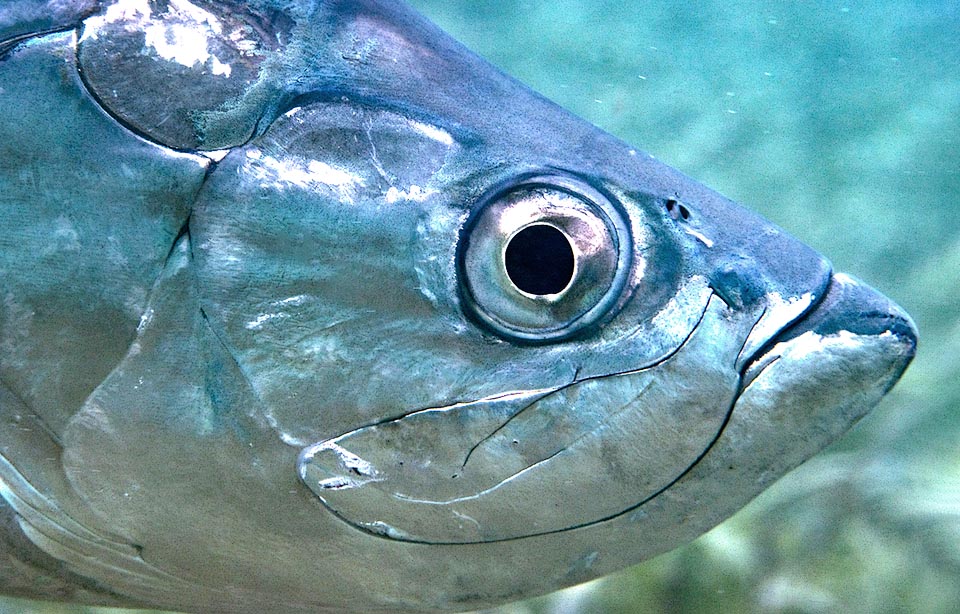
Doesn’t have big teeth but swallows the small preys whole and grinds the others held by thick and thin teeth on the robust bony plate at the centre of the lower jaw © Allison & Carlos Estape
Not yet satisfied, as happens in the Mediterranean with Suez Canal for the lessepsian species, Megalops atlanticus has entered the Pacific through Panama Canal and has been caught not far from Coiba Island.
Ecology-Habitat
It’s a fish that chiefly goes swimming in shallow waters, from the surface to 15 m of depth, going exceptionally up to 40 m even if in Florida there is somebody talking of 149 m.
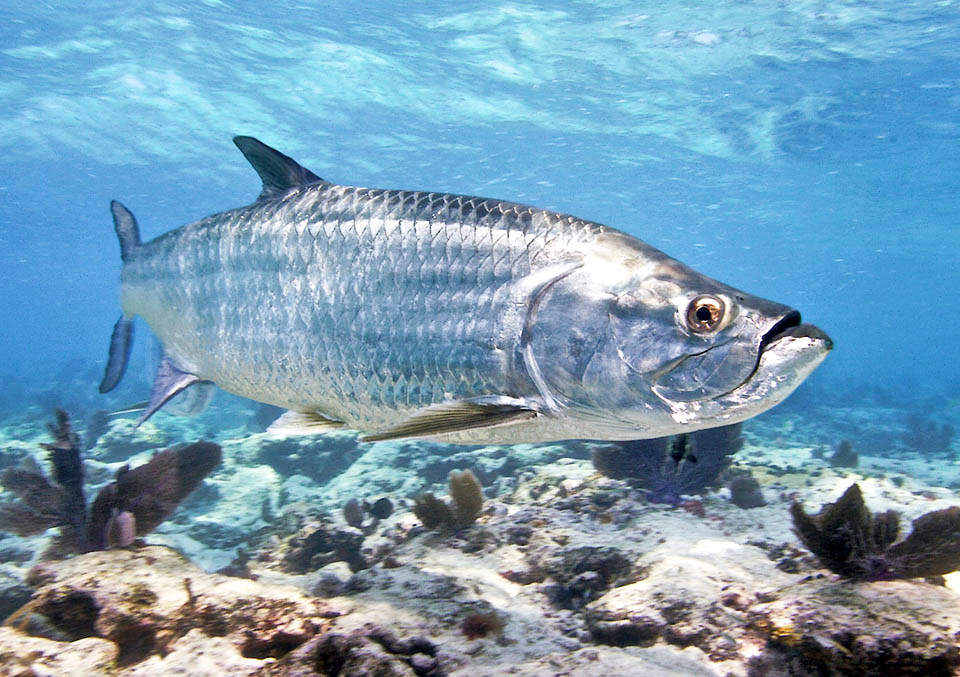
Swims in various environments, mainly between the surface and 15 m of depth but can be found also offshore where reproduces at 200-250 km far from coast © Allison & Carlos Estape
Megalops atlanticus accepts brackish waters and even the fresh waters going up the rivers for a while, but especially can do without the gills and breathes in waters poor in oxygen with its swim bladder. In fact, it is very vascularized, and since it communicates with the oesophagus, can be filled with air and used as a lung.
In these difficult environments, it preys practically without competitors and is threatened only by the Bull shark or Zambezi shark (Carcharhinus leucas), the Scalloped hammerhead (Sphyrna lewini) and some alligator, sport fishermen apart who consider it as a trophy.
Morphophysiology
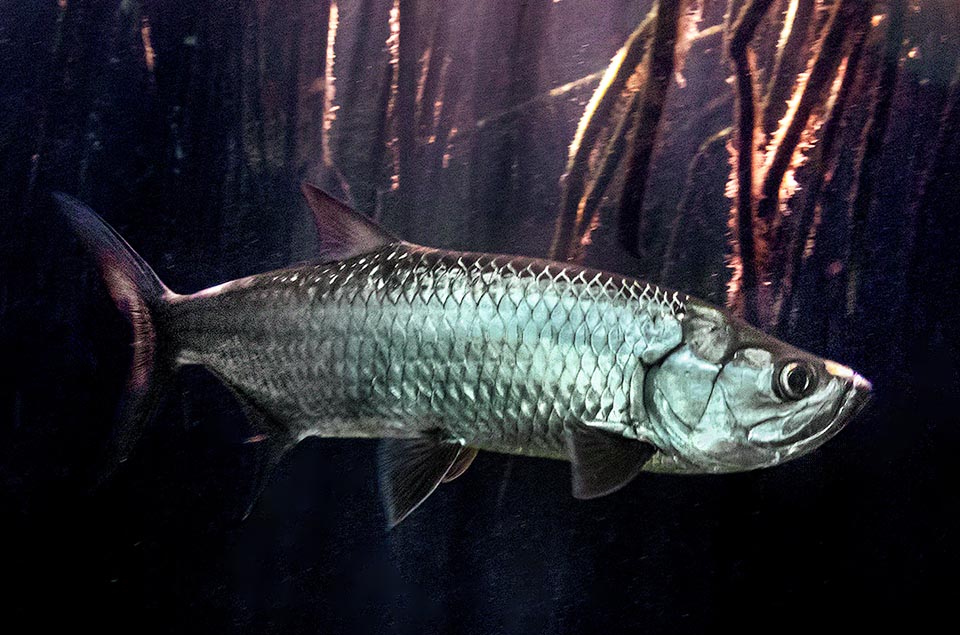
Here is among mangroves roots. Has a good game in fresh and brackish waters, marshes and swamps, where preys abound and predators are few © Neil DeMaster
Usually 130 cm long, with a record of 250 cm and a maximum weight of 151 kg, Megalops atlanticus is immediately recognized from the large silvery cycloid scales and the long and facing upwards lower jaw.
Between the sides of the latter has a robust bony plate for grinding fishes and crustaceans tha, if not swallowed whole, are held by small thick and thin teeth, villiform, present, as well as on the jaws, inside the mouth, including the tongue and the base of the skull.
All fins are spineless. The dorsal has 13-16 soft rays with the last one filamentous; the anal 22-25 rays; the pectoral ones 13-14 and the pelvic 10. The huge caudal fin is forked.
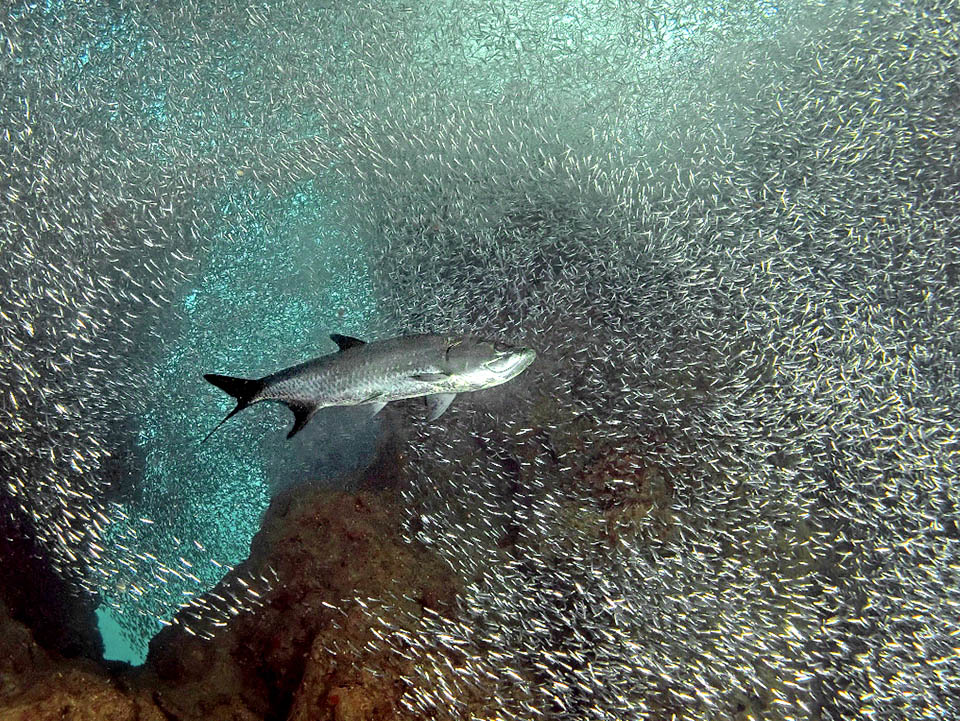
Of course, without forgetting crustaceans, it’s the terror of small fishes schools it swallows alive without effort © Mickey Charteris
When seen from above, these fishes often look dark blue, greenish black or of brass colour when swimming in inland waters, but from the side the livery is unmistakable seen the big scales, used for ornamental objects and for the creation of artificial pearls. In Brazil, they also attribute to them medicinal virtues.
The flesh, described as stinking and bony, is only good for subsistence and is an excellent excuse for some sport fishermen who enjoy making the wounded Siverkings jump out of the water taking advantage of their resistance and of their fighting spirit.
Almost always, after having taken the ritual photos on board, they free them even if most then die miserably.
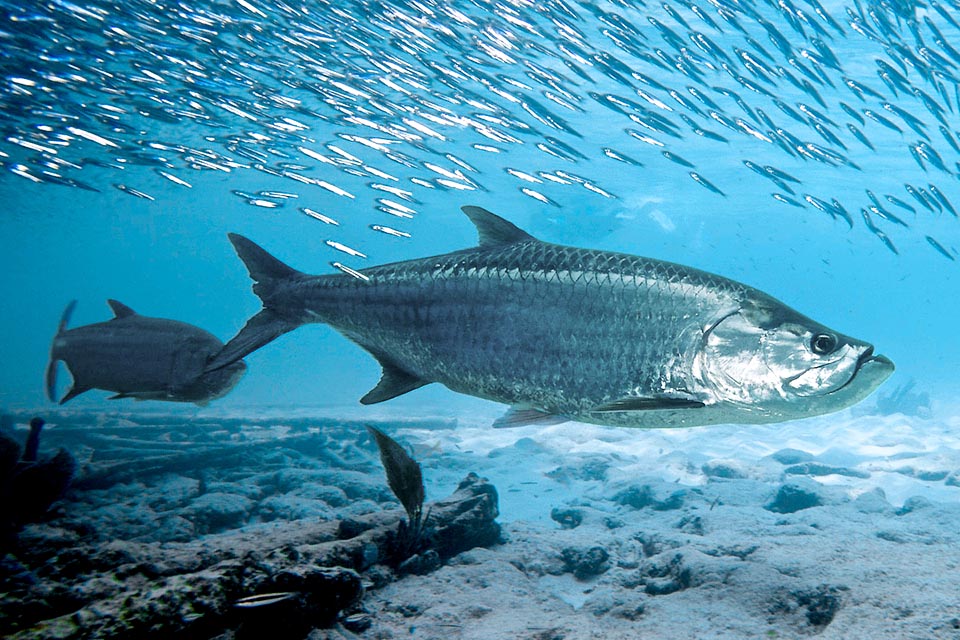
Sardines stand among its choice preys and is hunted by sharks, alligators and sport fishermen who seize it only for pleasure, as a trophy © Allison & Carlos Estape
Ethology-Reproductive Biology
Megalops atlanticus feeds both during the day and also at night on fishes swimming in midwate, especially if they move in schools like the sardines that are swallowed whole. Usually the males live 30 years and reach sexual maturity when about 7 years old and 88 cm long, whilst the females only about 10 years with 110 cm of length with a lifespan of 50 years, and a record, in an aquarium, of 63 years.
Just before reproduction we note gatherings at 2-25 km far from the coast, then for spawning they go further out in the ocean, at 200-250 km from the continent, where the currents are strong and every female, depending on the size, can lay 4,5 to more than 20 million of eggs.
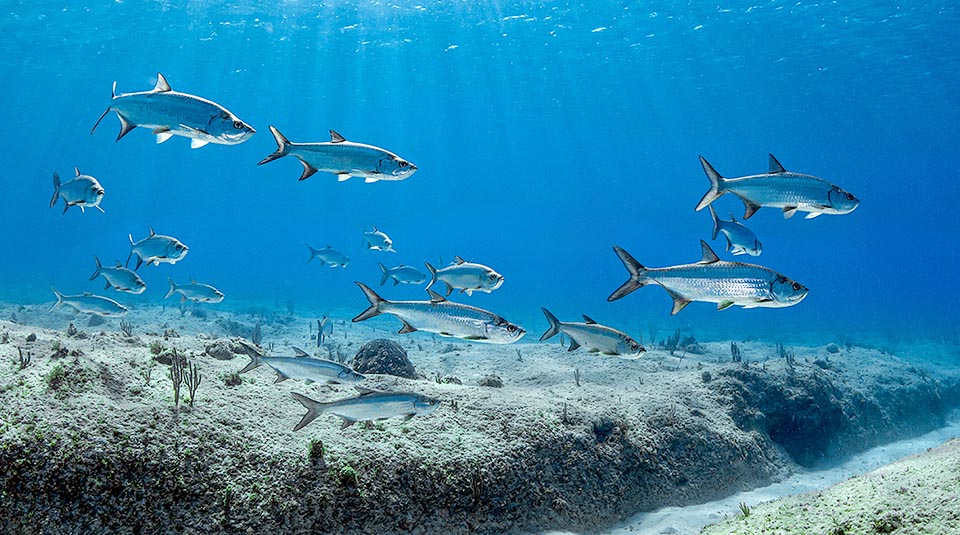
In the reproductive time gatherings form that meet in the ocean in groups estimated in over 25.000 individuals by means of acoustic surveys © Brian Cole
Also the larvae are planktonic, and as it happens for the eels and the morays, at a certain point they assume an elongated, nastriform shape, similar ro a transparent willow leaf, called leptocephalus and migrate towards the estuaries.
The leptocephali do not catch zooplankton, like the normal larvae of the fishes, but they grab tiny food particles carried by the currents. They can also swim backwards with fast undulatory movements or even they may curl assuming the look of a wandering cylinder making them similar to jellyfishes.
After the metamorphosis they move to stagnant waters poor in oxygen where the predators are scarce, nourishing of plankton, larvae, weeds, insects, small crustaceans and finally of small fishes, when by now, about 3 years old, are ready to reach the adults.
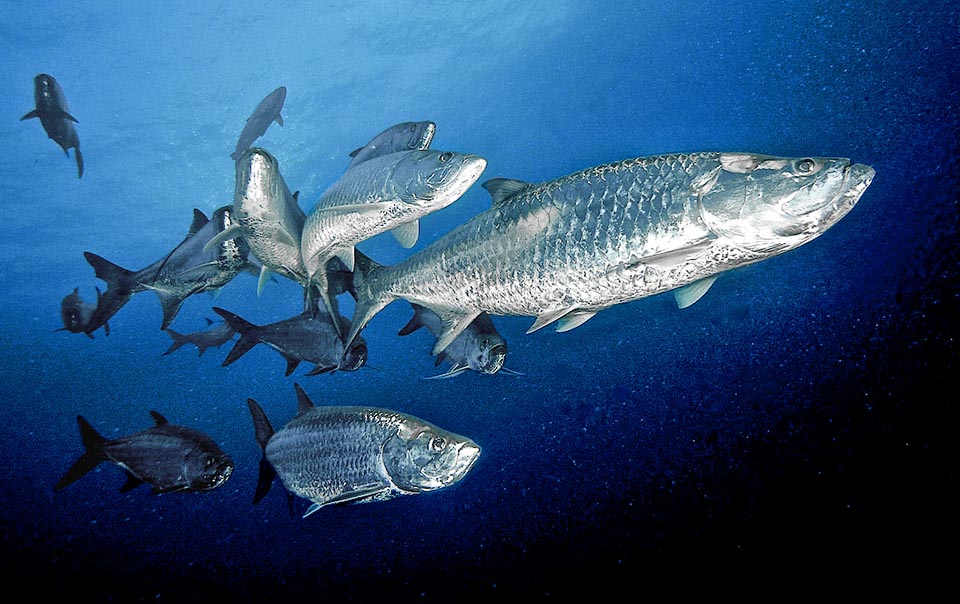
Females, larger and more long-lived, can lay depending on size 4,5 to more than 20 million of eggs. Also larvae are planktonic, and assume, like eels and morays, a shape similar to a transparent willow leaf, called leptocephalus. Megalops atlanticus appears as vulnerable in the IUCN Red List of endangered species © Allison & Carlos Estape
The resilience of the species is decidedly low with a possible doubling of the populations in 4,5-14 years and the fishing vulnerability, very high, marks 76 on a scale of 100 although the flesh, like many other fishes centered on the Caribbean, is at risk of ciguatera if they have predated often animals that store in their diet the toxin produced by the dinoflagellate Gambierdiscus toxicus.
The populations are declining and Megalops atlanticus appears from 2018 in the IUCN Red List of the endangered species as “VU, Vulnerable”.
Synonyms
Tarpon atlanticus (Valenciennes, 1847); Megalops elongatus Girard, 1859.
→ For general information about FISH please click here.
→ For general information about BONY FISH please click here
→ For general information about CARTILAGINOUS FISH please click here.
→ To appreciate the BIODIVERSITY of BONY FISH please click here.
→ To appreciate the BIODIVERSITY of CARTILAGINOUS FISH please click here.
